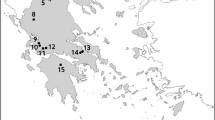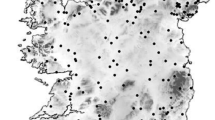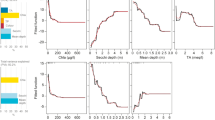Abstract
The objectives of this study were to establish a method of classifying plants as indicator species of eutrophication, as a key metric for assessing lake ecosystem health, and to select sensitive and tolerant plant species among aquatic macrophytes and hygrophytes. Thus, 38 natural and artificial lakes throughout Korea were investigated. The distribution and abundance of plant species were investigated. As a measure of eutrophication, the modified trophic state index (TSIKO), derived from total phosphorus and chlorophyll a, was used. Using TSIKO criteria and the response curves of plants to TSIKO, a selection method of classifying sensitive and tolerant species was developed. Overall, 15 sensitive and 11 tolerant species among 117 macrophytes and hygrophytes were classified. The applicability of the selected indicator species was verified by a comparison with the results of a multimetric analysis using eight variables. The results suggest that the selected indicator species is expected to be useful as a metric for assessing lake ecosystem health.





Similar content being viewed by others
References
Albert DA, Minc LD (2004) Plants as regional indicators of Great Lakes coastal wetland health. Aquat Ecosyst Health Manag 7:233–247
APHA (1998) Standard methods for the examination of water and wastewater, 20th edn. APHA, American Water Works Association, and Water Pollution Control Federation, Washington, DC
Birk S, Korte T, Hering D (2006) Intercalibration of assessment methods for macrophytes in lowland streams: direct comparison and analysis of common metrics. Hydrobiologia 566:417–430
Carbiener R, Tremolieres M, Mercier JL, Ortscheit A (1990) Aquatic macrophyte communities as bioindicators of eutrophication in calcareous oligosaprobe stream waters (Upper Rhine plain, Alsace). Vegetatio 86:71–88
Choi HK (2000) Aquatic vascular plants (Plants of Korea Series 5). Korea Research Institute of Bioscience and Biotechnology (KRIBB), Daejeon
Choi K-H (2003) Study on water quality environment and eco-physiological characteristics of phytoplankton growth in Lake Paldang. MS thesis, Konkuk University, Seoul (in Korean)
Choung Y, Lee WT, Cho K-H, Joo KY, Min BM, Hyun J-O, Lee KS (2012) Categorizing vascular plant species occurring in wetland ecosystems of the Korean Peninsula. Center for Aquatic Ecosystem Restoration, Chuncheon
Deegan B, Harrington TJ, Dundon P (2005) Effects of salinity and inundation regime on growth and distribution of Schoenoplectus triqueter. Aquat Bot 81:99–211
EC-European Communities (2000) Directive 2000/60/EC of the European Parliament and of the Council of 23 October 2000 establishing a framework for Community action in the field of water policy. OJ L 327, 22 Dec 2000
Heegaard E, Birks HH, Gibson CE, Smith SJ, Wolfe-Murphy S (2001) Species-environmental relationships of aquatic macrophytes in Northern Ireland. Aquat Bot 70:175–223
Heo W-M, Park D, Yoon S-O, Lee KS, Lee YS, Hwang SI, Choi JS, Lee EJ, Park JH, Lee SK, Kim YH (2009) Ecosystem studies for the conservation and restoration of lagoons in the east coast. Wonju Regional Environmental Office, Wonju (in Korean)
Kadono Y (2008) Aquatic plant of Japan. Bun-ichi Sogo Shuppan Co., Ltd., Tokyo
Karr JR (1981) Assessment of biotic integrity using fish communities. Fisheries 6:21–27
Karr JR, Chu EW (1997) Biological monitoring: essential foundation for ecological risk assessment. Hum Ecol Risk Assess 3:99–1004
Khedr AA (1997) Aquatic macrophyte distribution in Lake Manzala, Egypt. Int J Salt Lake Res 5:221–239
Kim B (2010) Evaluation of ecology integrity in lake ecosystem. Center for Aquatic Ecosystem Restoration, Chuncheon (in Korean)
Kim B (2013) Evaluation of ecological integrity in the lake ecosystems of Korea. Center for Aquatic Ecosystem Restoration, Chuncheon (in Korean)
Kim JH, Lee DJ (2002) Ecology of lentic organisms. Bookshill, Seoul (in Korean)
Kim S-N, Lee J-S (2003) Ecological characteristics and growth environment of Korean native water plants. J Korea Flower Res Soc 11:21–35 (in Korean)
Kim K, Jin S-N, Cho H, Cho K-H (2012) Distribution, vegetation structure and biomass of submerged macrophytes in a small agricultural reservoir, Keumpoong Reservoir, Korea. Korean J Limnol 45:52–61 (in Korean)
Kolada A (2010) The use of aquatic vegetation in lake assessment: testing the sensitivity of macrophyte metrics to anthropogenic pressures and water quality. Hydrobiologia 656:133–147
Korea National Arboretum (2004) Illustrated grasses of Korea. 1, Gramineae. Korea National Arboretum, Pocheon (in Korean)
Korea National Arboretum (2009) Rare plants data book in Korea. Geobook, Seoul
Kufel L, Krolikowska J, Kufel I (1996) Structure of submerged littoral vegetation in relation to pelagic trophic state indices. Ekol Pol 44:299–310
Lachavanne J-B, Perfetta J, Juge R (1992) Influence of water eutrophication on the macrophytic vegetation of Lake Lugano. Aquat Sci 54:351–363
Lacoul P, Freedman B (2006) Environmental influences on aquatic plants in freshwater ecosystem. Environ Rev 14:89–136
Lee WT (1996a) Standard illustrations of Korean plants. Academybook, Seoul (in Korean)
Lee WT (1996b) Lineamenta florae Koreae. Academybook, Seoul (in Korean)
Lee TB (2003) Coloured flora of Korea. Hyangmunsa, Seoul (in Korean)
Lee YK (2004a) Classification of Korea lakes based on trophic state parameters. MS thesis, Kangwon National University, Chuncheon (in Korean)
Lee Y-K (2004b) Syntaxonomy and synecology of the riparian vegetation in South Korea. Ph.D. thesis, Keimyung University, Daegu (in Korean)
Lee YN (2006) New flora of Korea. Kyohak Publishing Co., Ltd., Seoul (in Korean)
Lee K (2010) A study on riparian vegetation characteristics among the different types of wetland. MS thesis, Chung-Ang University, Seoul (in Korean)
Lee YK (2014) Development of Water Quality Index for lakes and reservoirs in Korea. Ph.D. thesis, Kangwon National University, Chuncheon (in Korean)
Lim Y (2009) Distribution characteristics of hydrophytes in Korea. Ph.D. thesis, Soonchunhyang University, Asan (in Korean)
Mack JJ, Micacchion M, Auausta LD, Sablak GR (2000) Vegetation indices of biotic integrity (VIBI) for wetlands and calibration of the Ohio rapid assessment method for wetlands (version 5). Final Report to U.S. Environmental Protection Agency. Ohio Environmental Protection Agency, Columbus
Melzer A (1999) Aquatic macrophytes as tools for lake management. Hydrobiologia 369–396:181–190
Miller SJ, Wardrop DH, Mahaney WM, Brooks RP (2006) A plant-based index of biological integrity (IBI) for headwater wetlands in central Pennsylvania. Ecol Indic 6:290–312
Ministry of Environment (2013) List of endangered plants. Ministry of Environment republic of Korea. http://nre.me.go.kr/. Accessed 27 July 2013
Moss B (1967) A spectrophotometer method for the estimation of percentage degradation of chlorophyll and pheo-pigments extracts of algae. Limnol Oceanogr 12:335–340
Moss B, Stephen D, Alvarez C, Becares E, Van der Bund W, Collings SE (2003) The determination of ecological status in shallow lakes-a tested system (ECOFRAME) for implementation of the European Water Framework Directive. Aquat Conserv Mar Freshw Ecosyst 13:507–549
Nichols S, Weber S, Shaw B (2000) A proposed aquatic plant community biotic index for Wisconsin lakes. Environ Manag 26:491–502
Odland A (1997) Development of vegetation in created wetlands in western Norway. Aquat Bot 59:45–62
Oh YC (2000) Korean Cyperaceae. Sungshin Women’s University Press, Seoul (in Korean)
Oh YC (2006) Korean Caricoideae of Cyperaceae. Sungshin Women’s University Press, Seoul (in Korean)
Park SH (2009) New illustrations and photographs of naturalized plants of Korea. Ilchokak, Seoul
Penning WE, Dudley M, Hanganu S, Kolada A, Van den Berg M, Poikane S, Phillips G, Willby N, Ecke F (2008) Classifying aquatic macrophytes as indicators of eutrophication in European lakes. Aquat Ecol 42:237–251
Rintanen T (1996) Changes in the flora and vegetation of 113 Finnish lake during 40 years. Ann Bot Fenn 33:101–122
Rothrock PE, Simon TP, Stewart PM (2008) Development, calibration, and validation of a littoral zone plant index of biotic integrity (PIBI) for lacustrine wetlands. Ecol Indic 8:79–88
Schaumburg J, Schranz C, Hofmann G, Stelzer D, Schneider S, Schmedtje U (2004) Macrophytes and phytobenthos as indicators of ecological states in German lakes—a contribution to the implementation of the Water Framework Directive. Limnologica 34:302–314
Schneider S (2007) Macrophyte trophic indicator values from a European perspective. Limnologica 37:281–289
Seddon B (1972) Aquatic macrophytes as limnological indicators. Freshw Biol 2:107–130
Seo A (2012) Classifying wetland plant species as indicator to eutrophication in lakes of Korea. MS thesis, Kangwon National University, Chuncheon (in Korean)
Shin H, Kim Y, Cho K-H, Choi H-K (1997) Relationship between the distribution of hydrophytes and water quality in Asan city, Korea with special reference to submerged hydrophytes. Korean J Limnol 30:423–429
Simon TP, Stewart PM, Rothrock PE (2001) Development of multimetric indices of biotic integrity for riverine and palustrine wetland plant communities along Southern Lake Michigan. Aquat Ecosyst Health Manag 4:293–309
Søndergaard M, Johansson LS, Lauridsen TL, Jørgensen TB, Liboriussen L, Jeppesen E (2010) Submerged macrophytes as indicators of the ecological quality of lakes. Freshw Biol 55:893–908
Stelzer D, Schneider S, Melzer A (2005) Macrophyte based assessment of lakes-a contribution to the implementation of the European Water Framework Directive in Germany. Int Rev Hydrobiol 90:223–237
Stewart PM (1995) Use of algae in aquatic pollution assessment. Nat Areas J 15:234–239
Swink F, Wilhelm G (1994) Plants of the Chicago region, 4th edn. Indiana Academy of Science, Indianapolis
Toivonen H (1985) Changes in the pleustic macrophyte flora of 54 small Finnish lakes in 30 years. Ann Bot Fenn 22:37–44
Toivonen H, Baeck S (1989) Changes in aquatic vegetation of a small eutrophicated and lowered lake (Southern Finland). Ann Bot Fenn 26:27–38
Toivonen H, Huttunen P (1995) Aquatic macrophytes and ecological gradients in 57 small lakes in southern Finland. Aquat Bot 51:197–221
Vestergaard O, Sand-Jensen K (2000) Alkalinity and trophic state regulate aquatic plant distribution in Danish lakes. Aquat Bot 67:85–107
Acknowledgments
This study was supported by the Center for Aquatic Ecosystem Restoration (CAER) of Eco-STAR project (EW42-08-10) from the Ministry of Environment (MOE, Republic of Korea). The authors are grateful to Yonghak Lee, Changwan Woo, Kiyong Hwang, Inyong Hwang, and Jihye Heo for their field assistance. Also, special thanks to guest editors.
Author information
Authors and Affiliations
Corresponding author
Additional information
Anna Seo and Kyungeun Lee are the co-first authors.
Rights and permissions
About this article
Cite this article
Seo, A., Lee, K., Kim, B. et al. Classifying plant species indicators of eutrophication in Korean lakes. Paddy Water Environ 12 (Suppl 1), 29–40 (2014). https://doi.org/10.1007/s10333-014-0437-z
Received:
Revised:
Accepted:
Published:
Issue Date:
DOI: https://doi.org/10.1007/s10333-014-0437-z




